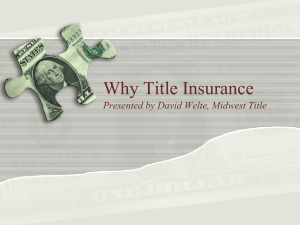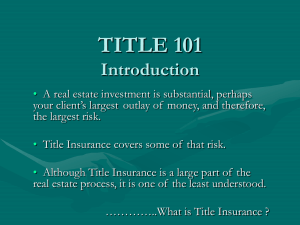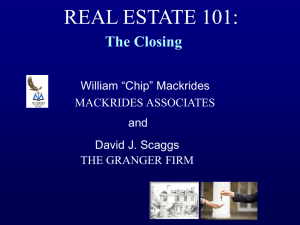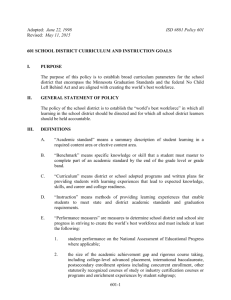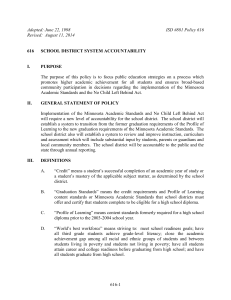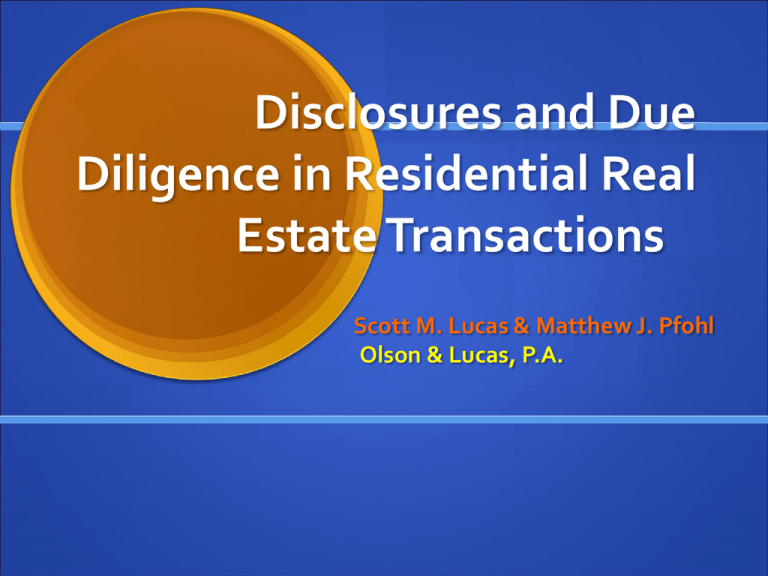
Disclosures and Due
Diligence in Residential Real
Estate Transactions
Scott M. Lucas & Matthew J. Pfohl
Olson & Lucas, P.A.
Introduction
Disclosures to be made by Sellers – §20.2
Disclosures to be made by Brokers & Agents
- §20.3
Due Diligence Concerns - §§20.4-20.9
p. 20-1
§20.2 Seller Disclosures
STATUTORY PROVISIONS
Minn. Stat. §§ 513.52 – 513.60
Practice Tip – Licensees shouldn’t assist with
form
Excluded Transactions – Minn. Stat. § 513.54
Pp. 20-1 & 20-2
What Seller MUST Disclose:
Minn. Stat. § 513.55
“All material facts of which the seller is aware that could
adversely and significantly affect:
An ordinary buyer’s use and enjoyment of the property, or:
Any intended use of the property of which the seller is
aware”
Damage, physical defects, failing mechanical systems,
water issues, construction mistakes
P. 20-2
But…No liability if:
Not within “personal knowledge”
Based entirely on information from “qualified
third party”
Obtained only through inspection or observation
of inaccessible parts of real estate or
Could only be discovered by person with expertise
in science or trade beyond knowledge of Seller
Minn. Stat. § 513.57, subd. 1
Pp. 20-2 & 20-3
What does NOT need to be disclosed:
If the occupant had AIDS or was HIV positive
If someone committed suicide or died there
Ghosts?
Neighborhood adult family home or residential
facility
Sex offenders
P. 20-3
Contradictions Must Be Disclosed
If Seller obtains a copy of a report and knows of
any material facts that contradict the
information, those facts must be disclosed.
Buyers: Give sellers your report!
Sellers: Obtain your own report?
P. 20-4
In the Event of Non-Disclosure
Sale Not Invalidated – Seek Damages
and other Equitable relief
Rescission is an equitable remedy
p. 20-5
Statue of Limitations
Minn. Stat. § 513.57, subd. 2: Commence
action within two years after closing on the
sale
Look for arbitration provision
P. 20-5
Relationship of Statute to
Common Law Claims
Per Minn. Stat. § 513.57, subd. 3:
Common law claims are NOT PRECLUDED
Negligent or Fraudulent Misrepresentation
Minnesota Consumer Fraud Act
Estoppel, Unjust Enrichment, Breach of Warranty
P. 20-5
Damages
Proof of alleged Damages is Required
Out of Pocket Rule
Not the “cost to fix” damages
Rather, FMV with the problem vs. FMV without the
problem
Difficult to Prove?
Not “off the cuff”
P. 20-6
Location of Wells /
Washington County Special Construction
Area
Property within Washington County
Minn. Adm. Rules section 4725.3650
Minn. Stat. section 103I.236
Disclose wells even if served by municipal
water
P. 20-13
§20.3 Licensee Disclosures
Generally
Brokers and Agents
P. 20-16
Material Facts Concerning
Condition of Property
Applicable Transactions
Certain Facts are Non-Material
Information in Certain Written Reports Need Not be
Disclosed
Disclosure Must be Made of Contradictions in Written
Reports
Liability for Non-Disclosure
Pp. 20-20 to 20-22
§20.5 Due Diligence: Condition of
the Property
Property Inspections
From Buyer’s perspective, advisable to include
Forms:
MSBA Form 18
MAR “Inspection Contingency Addendum”
If issues discovered, parties must reach an agreement to
address, or waive by a deadline
P. 20-30
ARRANGE INSPECTION QUICKLY.
Typically done on a short time frame.
Check the applicable deadlines right away.
Waived if not timely done.
P. 20-30
Government Mandated
Inspections
Local ordinances should be reviewed; some cities
impose inspection requirements.
Some ordinances require immediate correction of
hazardous conditions.
Many ordinances available on the Internet.
P. 20-31
Does Municipal Inspection Alter Seller
Duty ?
“unclear whether Minnesota’s Condition of the
Property disclosure law . . . allows a municipal
code inspection to serve as the third party
inspection report. To conclude ‘yes’ is a tenuous
judgment.” Todd J. Anlauf, Kimball Foster, and
John D. Rice
P. 20-31
Environmental Concerns
Phase I Environmental Site Assessment.
Used if there are concerns about hazardous waste
or other environmental issues.
May lead to environmental testing.
Unusual for residential transactions.
P. 20-31
Environmental Concerns . . .
Radon: Buyer can ask for testing.
Lead Paint: If the property was constructed
before 1978, the Buyer is to have ten days
to investigate the possibility of the
presence of lead or lead paint.
P. 20-31, 32
§ 20.6 Due Diligence: Title
Objectives of Title Review
Seller to provide marketable title.
“primary purpose of marketable title is to
protect the purchaser from the burden of
litigation that may be necessary to remove
apparent or real defects in the title” Glaser
P. 20-32
Another part of the title review
process. . .
make sure the property to be purchased will be
suitable for client needs.
“Buyers should also consider whether easements,
restrictions, covenants, agreements and other
matters of record would interfere with Buyer’s
intended use of the property . . .” Anlauf, Foster,
Rice.
P. 20-32
EVIDENCE OF TITLE
Seller furnishes either:
Updated abstract , or
a commitment to provide an owner’s policy of
title insurance.
If there is any concern that Buyer will be called
upon later to provide an abstract, Buyer should
request updated abstract.
P. 20-32,33
Form of Title Commitment
Conditions section: Lists conditions of coverage.
Schedule A describes the property, lists the
owner, names the insureds, and states the dollar
value of the coverage amounts.
Schedule B-I states the requirements that the title
insurer will impose to insure title.
Schedule B-II states the exceptions from
coverage.
P. 20-33
Making Title Objections
Timing of Objections
MAR Form “Purchase Agreement” :
“Seller shall use Seller’s best efforts to
provide marketable title by the date of
closing.”
P. 20-33
MSBA form : Specific timeframe.
If an abstract is provided, Buyer has ten days
to either make title objections, or order its
own commitment for a title insurance policy.
If Buyer receives a commitment, it has ten
days from receipt of it to provide Seller with
Buyer’s title objections.
Objections not timely made are waived.
P. 20-33
Buyer’s Title Commitment
Review
Provide written objections to the seller or seller’s
counsel, and to the closing agent issuing the
commitment.
Thoroughly review the commitment to determine
which objections to make.
See materials – P. 20-34.
PRACTICE TIP: DELETE THE
SURVEY EXCEPTION.
Standard exception in Schedule B-II for “[a]ny . . .
adverse circumstance affecting the Title that
would be disclosed by an accurate and complete
survey of the Land.”
However, closing agents may delete that survey
exception for residential properties upon request,
if a visual inspection of the property is made, or if
a “plat drawing” is obtained.
P. 20-34
§ 20.7 DUE DILIGENCE: THE
CLOSING PROCESS
Closing Instructions
Certain protections in the ALTA form
Closing Protection Letter, discussed
below, are based on protecting the owner
or mortgagee from the closing agent’s
failure to follow written closing
instructions.
P. 20-36.
TIMING: ALTA Closing Protection Letter form
requires that the “binder or commitment for the
issuance of a policy of title insurance . . . must
have been received by you prior to the
transmission of your final closing instructions.”
P. 20-36
The Closing Protection Letter
Issued by the underwriter. Protects against:
“Failure of the issuing agent or approved attorney to
comply with your written closing instructions to the
extent that they relate to . . . status of the title to said
interest in land. . . ”
“Fraud or dishonesty of the issuing agent or approved
attorney in handling the funds or documents in
connection with such closings to the extent such fraud
or dishonesty relates to the status of the title to said
interest in land or to the validity, enforceability, and
priority of the lien of said mortgage on said interest in
land.”
P. 20-37
“A closing protection letter is typically issued by a title
insurance underwriter ‘[t]o verify the agent's authority to
issue the underwriter's policies and to make the financial
resources of the national title insurance underwriter
available to indemnify lenders and purchasers for the local
agent's errors or dishonesty with escrow or closing funds.”
New Freedom Mortgage Corp. v. Globe Mortg. Corp. 761
N.W.2d 832, 842 – 843 (Mich. Ct. App. 2008), (emphasis
added), quoting 2 PALOMAR, TITLE INSURANCE LAW, § 20:11.
P. 20-38.



